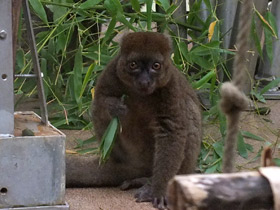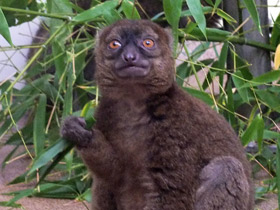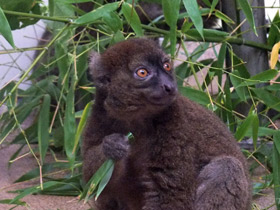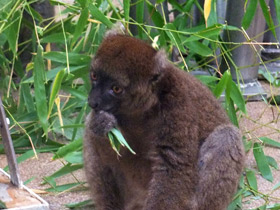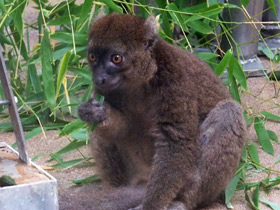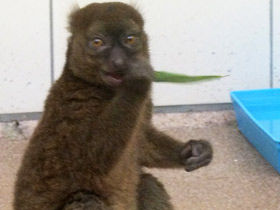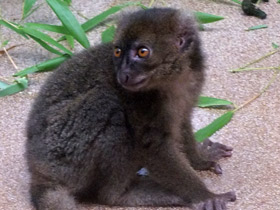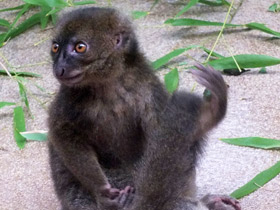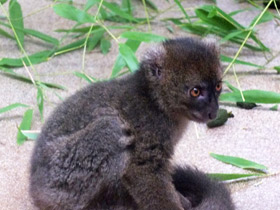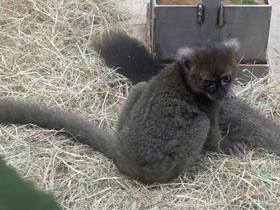The greater bamboo lemur (Hapalemur simus o Prolemur simus), the broad-nosed bamboo lemur and the broad-nosed gentle lemur
The greater bamboo lemur (Hapalemur simus o Prolemur simus), also known as the broad-nosed bamboo lemur and the broad-nosed gentle lemur, is a species of lemur endemic to the island of Madagascar.
The greater bamboo lemur (Hapalemur simus or Prolemur simus), the broad-nosed bamboo lemur and the broad-nosed gentle lemur is a species of strepsirrhine primate in the family Lemuridae, the largest of the three species of bamboo lemur. It is the only representative of the genus Prolemur.
Particularities and habitat
Prolemur simus is the largest of the bamboo lemur species. Its most distinctive feature is a pair of large, prominent white ear tufts.
Prolemur simus was previously thought to occur only in western, northern and central Madagascar, but in the early 1990s the species was discovered in several new localities.
In the Andringitra region, Prolemur simus has been found up to altitudes of 1210-1625m. Prolemur simus prefers to live in primary forest and is closely associated with giant bamboo thickets.
The species is also introduced into agricultural plantations, which are adjacent to bamboo thickets.
At present, due to continued destruction of Prolemur simus rainforest habitats, human agricultural activities and poaching, the distribution of this lemur is limited to a few isolated patches of rainforest.
At present, the species numbers over 500 individuals in 11 small subpopulations, but unfortunately none of these numbers more than 250 adults.
Prolemur simus is listed as Critically Endangered on the IUCN Red List.
Appearance
Prolemur simus has greyish skin on the dorsal side, and olive or greenish-brown skin on the shoulders and top of the head. Lemurs of this species from a recently discovered isolated settlement have golden-red fur. The underside of the abdomen is greyish brown. The tail of this species is greyish brown at the base and darker at the tip.
Prolemur simus has a large scent gland in the throat. Its muzzle is dark, its cheeks, forehead and throat are brownish-grey. The body length of the largest bamboo lemur is about 45-48 cm, the tail is about 44 cm, and it weighs between 2.2 and 2.5 (and on average 2.4) kg.
Way of life
Prolemur simus has a crepuscular-night life: it is active at dawn and dusk, and often at night. Lemurs live in groups of 4 to 7 to 12 individuals. Their range can vary from 62 to 100 hectares.
Vocal communication plays an important role in the life of these lemurs. The signal to gather the group is a loud, shrill sound, which increases in intensity and then decreases rapidly as it is played. When the Prolemur simus is very disturbed or frightened, it emits a low roar.
Nutrition
Prolemur simus is a plant-eating species, mainly feeding on bamboo. Its front teeth are well developed and specialised for eating bamboo. In a study of a group of Prolemur simus, it was found that they spent 95% of their time eating only one species of plant, giant bamboo, 3% on other types of bamboo, 0.5% on fruits and 1.5% on other types of food (mainly mushrooms). Thus, almost 98% of the diet consists of very low calorie foods.
Prolemur simus consumes different parts of bamboo depending on the season. Between July and November, the larger lemur mainly consumes the core of the giant bamboo. It obtains the soft core by tearing the woody shoots of the bamboo with its powerful mandibles. When new bamboo shoots start to grow (usually in December), the large bamboo lemurs move on to them completely. Interestingly, Prolemures simus eat young shoots that contain cyanide in quantities that would be lethal to any other animal or human.
Reproduction
The mating season for Prolemur simus runs from May to June, with females usually giving birth in November, before the rainy season arrives. After 149 days of gestation, the female gives birth to one calf each year. Females have one pair of teats.
Babies remain in constant contact with their mothers until they are five weeks old and feed on milk until they are eight months old.
When young males reach the age of 3 to 4 years, they reach sexual maturity and leave the breeding group.
The maximum lifespan of this species in captivity is 15 years, whereas in the wild they live considerably less. Threats to the survival of Prolemur simus include the continued destruction of its habitat in the bamboo rainforest: slash and burn of the forest and the creation of agricultural land in its place.

















